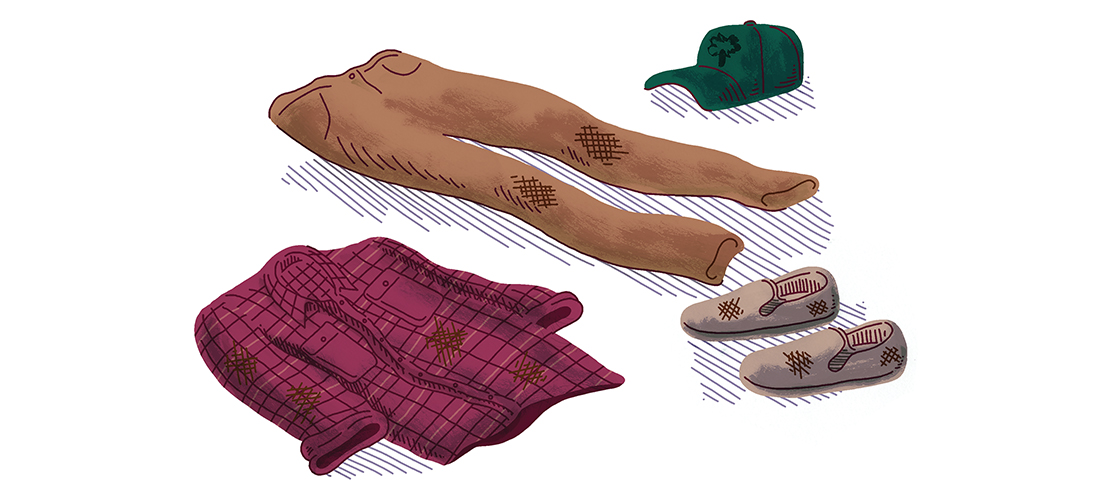The Pleasures of Life Dept.
Drama Queens
TTNC’s directors Brenda Schleunes and Donna Bradby rule the documentary theater scene
By Maria Johnson
A prediction for April 21st: Local theater folks and their supporters will cram the third-floor cabaret of Triad Stage for an evening honoring the 35th anniversary of Greensboro-based Touring Theatre of North Carolina.
A pre-show party will warm up the crowd for the premiere of the theater’s 50th production: The Melody of All That, a tune-filled bio of American song makers George and Ira Gershwin.
Guests will sip, titter, nibble and schmooze around a silent auction. A few people will address the faithful, pointing out the former TTNC board presidents. Polite applause will ensue.
The speakers will include the theater’s founder Brenda Schleunes, a Midwestern lass of Mennonite stock who looks, nevertheless, as if she’d been plucked from the streets of New York, with her black shawls, precisely clipped white hair and a bearing etched with gravitas. At 77, she’s the Maestra. She holds the title of artistic director, meaning she shoulders a lighter load than she used to. Last year, she shed the mantle of executive director.
Donna Bradby, the company’s new executive director, will make a few remarks, too. She’ll be the lady in braids and big earrings and a colorful skirt. Homegrown and springy at 56, she is quick and boisterous and grounded by a deep understanding of her craft, much of it gleaned from years of working with Schleunes (pronounced SHLOY-nes).
When the lights flicker on and off, the patrons will funnel to their tables, and the show will go on, in a way that happens only here, because this shoestring nonprofit is very likely one-of-a-kind among theater companies in the country.
As the name suggests, TTNC takes its shows on the road, apart from short runs on the home turf in Greensboro.
But the name doesn’t convey the group’s rarity on several fronts.
To find two women at the helm of a theater company, even a small one, is worth noting.
“It’s mostly a man’s game,” says Bradby. “Theater is a business, so all the ramifications of being a female in any business plague women in the theater and entertainment world.”
Another distinction: All but one of the company’s 50 shows have been original productions, adapted to the stage by Schleunes, who mines printed material including everything but ready-made scripts — novels, short stories, poems, biographies, footnotes, documents, letters and transcripts of interviews.
“She stages things that weren’t meant to be staged,” says Bradby.
The shows use minimal props and six or fewer actors.
No one else does that. At least not at the clip of at least one new show a year. Not for 35 years. And not while handling — between feel-good pieces like the Gershwin show — heavy-duty issues of the past and present.
To wit: The Holocaust; slavery; civil rights; the decline of textile mills and its ripple effect; bullying; aging; capital punishment; gay marriage; homelessness; the emotional toll of separated military families.
Sensitive subjects?
“She’s not scared,” Bradby says of her mentor. “She ain’t nobody’s punk where theater is concerned.”
“Nobody’s punk” grew up in northernwestern Ohio, in a village named Archbold, which was memorable for its population: 1,234.
Schleunes’ mother died in childbirth, and baby Brenda Pursel spent her formative years in the lap of her Mennonite maternal great-grandmother.
“She was one of those people who looked like she was made of goose down pillows,” says Schleunes.
With loving arms around her and books propped in front of her, little Brenda came to love literature. Her favorite?
“A multi-ethnic nursery rhyme book, if you can believe it,” she says.
No one was surprised when she studied theater and English in college; or when she acted and edited literature textbooks in Chicago; or when — after moving here in 1971 when her husband Karl took a job teaching German history at UNCG — she pursued a Master’s degree in performance studies at UNC-Chapel Hill.
“We studied literature to see how it could be staged,” she says.
Her first audiences were school children, including her daughter Anna’s classmates at J.C. Price Elementary, then a traditional magnet school.
But Schleunes didn’t want her future work to be confined to kiddies, so she gave her new venture a more elastic name: Touring Theatre Ensemble. That was 1982.
Four years later, Schleunes courted adults by adapting two Eudora Welty short stories. The show starred Bradby, whom Schleunes had recruited while Bradby was a theater student at N.C. A&T State University. By the time the curtain rose, Bradby had graduated. She was also eight months pregnant and playing a 90-year-old woman. “I said, just bend lower and keep your shawl pulled over the front,” Schleunes recalls, laughing.
Welty saw the show at Greensboro College while she was in town for another literary event. Afterward, she signed Schleunes’ copy of her collected stories. “To Brenda,” Welty wrote in a spidery hand. “With thanks for your fine performance of my story.”
Schleunes feasted on the words of other well-known authors. She adapted Alice Walker. She interpreted North Carolina writers, too, drawing early on from Marianne Gingher, Lee Smith, Jill McCorkle, Randall Jarrell and Sandra Redding.
Later, she derived from the works of Randall Kenan, Jaki Shelton Greene, Kathryn Stripling Byer, Fred Chappell and Todd Johnson.
Schleunes converted all kinds of words from page to stage. A trip to Israel yielded Letters from Leokadia, based on letters from a German Catholic woman to the Jewish girl she saved during the Holocaust.
The company took the Leokadia to the now-defunct Corcoran Gallery of Art in Washington, D.C., in 1993. The same year, Schleunes tweaked the group’s name, dropping “ensemble” and adding “North Carolina” as a regional identifier.
Then, with an eye to the road, she built her most popular show to date, Let My People Go: The Trials of Bondage in Words of Master and Slave. Her co-creator was Loren Schweninger, then a professor of history at UNCG, who harvested the show’s raw material from court documents. Schleunes strung the facts on a ribbon of music. “It was organized thematically with spirituals,” she says. The show opened in the mid-’90s and toured the country for nine years. Stops included the National Archives in Washington, D.C., and the U.S. Department of Interior theater.
The production also played a slew of universities, where some audience members learned things that didn’t sit well with them, including the fact that there had been black slaveholders in early America.
Schleunes remembers an uncomfortable moment at Elizabeth City State University, a predominantly African-American campus. “Somebody said to Loren, ‘You’d better watch out because I’m Nat Turner and I’m going to get you,’” Schleunces says, repeating the reference to a slave who led a murderous rebellion in Virginia in 1831.
There was no uprising in Elizabeth City that night.
The show’s beautiful moments outnumbered the scary ones. At Somerset Place, a former plantation near the town of Plymouth, the cast walked along a row of sycamore trees by a lake and sang, “Let My People Go,” before entering the auditorium. “It was haunting,” says Bradby. “It was like the spirits were there.”
Bradby, a Greensboro native, ducked in and out of her hometown. She acted in New York, then returned to oversee the transformation of the city’s Caldcleugh Recreation Center to a multicultural arts center. Then it was off to Virginia Tech for a Master’s degree in arts administration. Then back home to teach.
All along, she stayed involved with TTNC because she believed in promoting literacy through theater. She also valued Schleunes’ devotion and directness. She tells a story of going to Schleunes’ home to polish her lines for a show. “I was sweating, I was working so hard. When I was done, I looked at Brenda, and I was like, “Did you like my work?’ She looked at me and said, “Hmmm. It was very soporific.’ I had never heard that word before in my life. I was like, ‘What does soporific mean?’ She said, ‘Sleep-inducing,’ “ says a chuckling, head-shaking Bradby.
“With Brenda, there is no gray area. You leave knowing exactly what you need to do, how you need to come in the next rehearsal.”
When Schleunes decided to step down from the executive director’s job last year — “I was tired,” she admits — Bradby was the natural choice to replace her.
“It made perfect sense,” says Schleunes. “She knew the theater every bit as well as I did, and most of all, she was appreciative of our style.”
Bradby, who teaches and does arts marketing for A&T, wasn’t sure she wanted another job, so she took the company for a test drive without pay. During that time, she attended an award ceremony flush with local arts leaders; not one was a black woman.
“I said, ‘I’m gonna take the position,’ ” she says.
Bradby assumed control of booking, bill paying and fundraising. In the company’s early years, money flowed freely from state and local arts councils, historical organizations, foundations and private donors. The funding stream has narrowed in recent years. To finance new shows, which cost $10,000 to $20,000 each to create and perform, Bradby hopes to enlist new sponsors. She also wants to boost the company’s profile in its own backyard. To raise awareness, TTNC launched a home season in Greensboro five years ago.
The Up-Stage Cabaret at Triad Stage has become the performance headquarters. This year’s season begins with The Memory of All That: A Bio Cabaret of Gershwin Songs.
Bradby also pushes the company’s bedrock, the touring performances that deliver Schleunes’s work to schools, churches, synagogues, homes, community centers and other grass-roots venues. “The bookings are up,” says Schleunes. “She’s doing a fantastic job.”
Five shows are currently for hire: The Life and Times of Fannie Lou Hamer, the story of the hymn-singing civil rights leader from Sunflower County, Mississippi; Star-Spangled Girls: A Salute to the Women of World War II, which was commissioned by UNCG’s Jackson Library; Let Your Children Tell, which rests on the diaries of young people caught in the Holocaust; Duke Ellington Uptown, a tribute to the jazz composer; and Deployed, a readers’ theater featuring the words of veterans and their families from seven wars.
The Gershwin piece probably will join the nomadic pack.
With Schleunes calling the artistic shots, new productions are sure to include timely, if edgy, subjects. She’s doing preliminary work for a show that deals with implicit bias in law enforcement.
“There’s been an awful lot of that in the last three years . . . and it’s still happening,” Schleunes says. “In order to really look at this thing, you gotta put it up in front of people and say, ‘OK, here’s what happened.’ I’m not gonna say, “This is wrong or right,’ but, ‘Here’s what happened.’”
She says she hasn’t found the unifying principle of the show — “This is the toughest one I’ve done”— but she’s confident she will.
“After this many years, you have to have a little faith in yourself,” she says. OH
To learn more about the Touring Theatre of North Carolina, go to at ttnc.org.
Maria Johnson is a contributing editor of O.Henry. She can ne reached at ohenrymaria@gmail.com.








